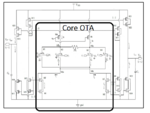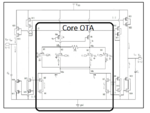student14
Member level 2
I want to reduce input referred noise of an op-amp more specifically of an OTA. OTA is to be designed for low frequency filter. For low frequency as fc = gm/CL, therefore for low frequency I need low gm value. Due to this small gm my noise is very high around 900uV/sqrtHz. How can I reduce this input referred noise.
In literature I have seen circuits designed with very low noise below 10uV/sqrtHz or even in nV/sqrtHz. I am designing a bulk driven OTA as attached but input referred noise is very high.
Any suggestions for reducing Noise. I have tried increasing the length for low flicker noise. I have also used PMOS differential pairs but still noise is quite high.
I am replicating the circuit shown in figure attached taken from one research article.
I have also tried to simulate the noise of core OTA as shown in figure2 attached. Reason for using core OTA to reduce noise coming from the cascode loads so I just kept considering the core OTA. But as source degeneration MOS is used of high Resistor value around 10M ohm. the gm of core OTA is very low in 30 nA/V. How to reduce this Noise Any suggestions?

In literature I have seen circuits designed with very low noise below 10uV/sqrtHz or even in nV/sqrtHz. I am designing a bulk driven OTA as attached but input referred noise is very high.
Any suggestions for reducing Noise. I have tried increasing the length for low flicker noise. I have also used PMOS differential pairs but still noise is quite high.
I am replicating the circuit shown in figure attached taken from one research article.
I have also tried to simulate the noise of core OTA as shown in figure2 attached. Reason for using core OTA to reduce noise coming from the cascode loads so I just kept considering the core OTA. But as source degeneration MOS is used of high Resistor value around 10M ohm. the gm of core OTA is very low in 30 nA/V. How to reduce this Noise Any suggestions?


